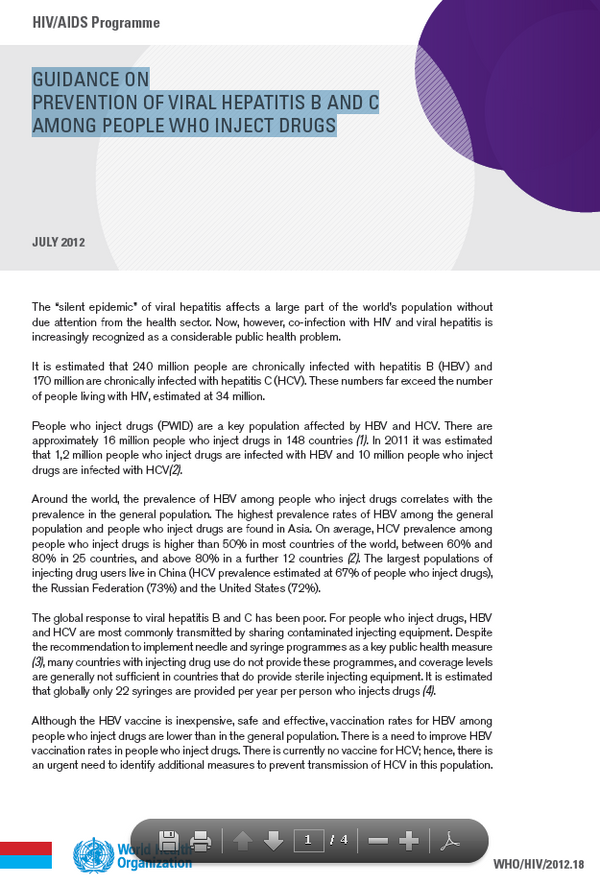WHO: Guidance on Prevention of Viral Hepatitis B and C Among People Who Inject Drugs
WHO has identified four key actions countries can take to prevent viral hepatitis B and C among people who inject drugs. Of the estimated 16 million people who inject drugs worldwide, it is estimated that 10 million are infected with hepatitis C. An additional 1.2 million are infected with hepatitis B.
Risk from shared syringes and needles
Many drug users are unable to obtain sterile syringes: in some countries it is illegal to distribute or possess syringes for non-medical purposes. The risk of contracting hepatitis and HIV infection occurs when people share syringes and needles. Used injection equipment retains traces of blood. If that blood contains HIV, hepatitis or another type of virus, the next person using the syringe could be infected.
Reducing the risk of HIV and hepatitis infections
A number of countries have established programmes to reduce HIV infections among people who inject drugs.
“Most of the interventions that prevent HIV transmission between people who inject drugs are virtually the same as those for preventing viral hepatitis B and C,” says Dr Gottfried Hirnschall, Director of the WHO Department for HIV/AIDS. “So it makes sense to reduce the risk of both infections by linking viral hepatitis prevention with HIV prevention, care and treatment.”
Hepatitis is an inflammation of the liver. Together, hepatitis B and C are the most common cause of cirrhosis and cancer of the liver. Viral hepatitis progresses faster among people living with HIV because their immune systems are weaker, and causes more severe liver-related health problems than it does among people without HIV infection.
WHO recommendations
WHO recommends:
- Implementing and scaling up HIV prevention programmes such as clean needle and syringe programmes and opioid substitution therapy (treatment of opioid dependence with methadone or buprenophine).
- Offering people who inject drugs the rapid hepatitis B vaccination regimen (completed in 3 weeks instead of 6 months), along with incentives to increase uptake and completion of the vaccine schedule. More than 175 countries now include a cheap, safe and effective vaccine against hepatitis B in their national infant immunization schedules. WHO has already recommended countries provide catch-up vaccination for people at increased risk of hepatitis infection, including injection drug users, but this does still not occur systematically at present. There is no vaccine against hepatitis C.
- Using “low dead space” syringes that retain less blood after use reduces the survival of HIV and hepatitis C in the blood that remains in the syringe. This potentially reduces the risk of transmission if injecting equipment is shared.
- Involving drug users in hepatitis prevention programmes to maximize their impact.
Public health approach
“Countries that have adopted a public health approach to injecting drug use and HIV have been the most successful in turning round their HIV epidemics. We need to do the same for hepatitis,” says Dr Ying-Ru Lo of the HIV Department at WHO.
The new evidence-based guidelines are designed for use by national public health officials, managers of HIV, drug dependence and harm reduction programmes, civil society and health workers in low- and middle-income countries. They are intended to be tailored and implemented according to local situations and needs.
Keep up-to-date with drug policy developments by subscribing to the IDPC Monthly Alert.
Downloads
Regions
Related Profiles
- World Health Organization (WHO)
